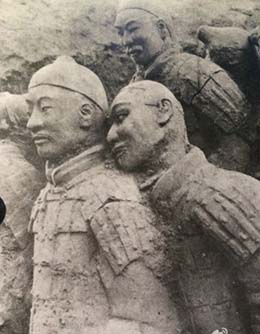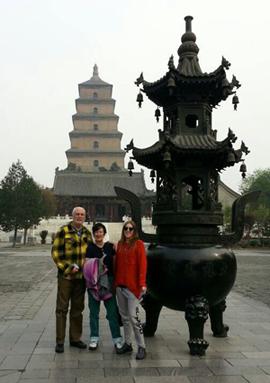Xian 2-day 1-night Package Tour or Weekend Tour

|

|
|
Xian 2-Day & 1-Night Tour or Weekend Tour Package
Weekend Tour from Beijing or
Shanghai to
Terracotta Warriors, Huaqing Hot Springs, City Wall, Big Wild Goose Pagoda
Make your own Terra Cotta
Warrior and take it home!
|
|
In March 1974, a group of peasants digging a
well in drought-parched Shaanxi province in
northwest China unearthed fragments of a clay
figure�the first evidence of what would turn out
to be one of the greatest archaeological
discoveries of modern times. Near the
unexcavated tomb of Qin Shi Huangdi�who had
proclaimed himself first emperor of China in 221
B.C.�lay an extraordinary underground treasure:
an entire army of life-size terra cotta soldiers
and horses, interred for more than 2,000 years.
The site, where Qin Shi Huangdi's ancient
capital of Xianyang once stood, lies a half-hour
drive from Xian. It is a dry, scrubby land
planted in persimmon and pomegranate that is
marked by dun-colored hills pocked with caves.
Highlights:
� Experience Xian, China�s �valley of the
kings� and the country�s ancient capital, which is
bursting with history and culture at every turn
� View the Terracotta Warriors and Horse, China�s most
amazing archaeological discovery and one of the world�s
true wonders
� Make your own Terracotta
Warriors and bring it home!
� Enjoy the golden age of China in a sumptuous dinner
show showcasing traditional dancing and costumes
B= Breakfast
L= lunch D= dinner
|
| |
TOUR ITINERARY |
 |
Tour
code:
GWAC-XA-01 |
|
DAY 1: ARRIVE IN XI'AN (L, D)
In the morning you will arrive in Xian (either by train
or by plane), and you will be met at the train station
or airport by your English-speaking guide. You�ll be
taken first to your hotel, in downtown Xian. After a bit
of freshening up, you�ll be taken to the premier
highlight of Xian, and one of the world�s great
treasures, the Terracotta Warriors and Horses Museum.
 The
Terra Cotta Warriors and Horses are the most
significant archeological excavations of the 20th
century. Work is ongoing at this site, which is around
1.5 kilometers east of Emperor Qin Shi Huang's
Mausoleum. It is a sight not to be missed by any visitor
to China. Upon ascending the throne at the age of 13 (in
246 BC), Qin Shi Huang, later the first Emperor of all
of China, had begun to work for his mausoleum. It took
11 years to finish. It is speculated that many buried
treasures and sacrificial objects had accompanied the
emperor in his after life. A group of peasants uncovered
some pottery while digging for a well nearby the royal
tomb in 1974. Life size terracotta figures of warriors
and horses arranged in battle formations are the star
features at the museum. They are replicas of what the
imperial guard should look like in those days of pomp
and vigor. The
Terra Cotta Warriors and Horses are the most
significant archeological excavations of the 20th
century. Work is ongoing at this site, which is around
1.5 kilometers east of Emperor Qin Shi Huang's
Mausoleum. It is a sight not to be missed by any visitor
to China. Upon ascending the throne at the age of 13 (in
246 BC), Qin Shi Huang, later the first Emperor of all
of China, had begun to work for his mausoleum. It took
11 years to finish. It is speculated that many buried
treasures and sacrificial objects had accompanied the
emperor in his after life. A group of peasants uncovered
some pottery while digging for a well nearby the royal
tomb in 1974. Life size terracotta figures of warriors
and horses arranged in battle formations are the star
features at the museum. They are replicas of what the
imperial guard should look like in those days of pomp
and vigor.
MAKE YOUR OWN TERRACOTTA WARRIOR!
You will have an opportunity to visit the Terracotta
Reproduction Factory before you see the real Terracotta
to get an introduction to the craftsmanship. At the factory, talented craftsmen
make these life size replicas in the same manner as
their counterparts did two thousand years ago - with
just their hands, a few basic tools, and clay. By
watching how a terracotta is made, you can try to make
your own miniature reproduction of the famous artifact
and take it home!
After visiting the warriors, you�ll be taken for
some relaxation and fun at the
Huaqing
Hot Springs. The Huaqing Hot Springs has been the
site of a famous imperial bathing pool and various
palace complexes over its 3,000-year history. It is a
National Cultural Relic and one of China�s Hundred
Famous Gardens.
Huaqing (Hua means brilliant, Chinese or flowery;
qing means pure or clear) Hot Springs is located about
35 kilometers east of the city of Xi'an, at the foot of
Li Mountain. The present day site is only a small part
of the Tang Dynasty Palace, covering an area of 85,560
square meters. Entering by the west gate to the hot
spring, you will see Nine Dragon Pool, Lotus Flower Pool
and Frost Drifting Hall. All these structures were
rebuilt in 1959 according to the Tang architectural
style.
For dinner, you�ll have a real treat in store for
you in the form of the
Tang Dynasty Music and Dance
Show. The Tang Dynasty Music and Dance Show, a wonderful
performance of the ancient music and dance, is a must
when you visit Xian. The city, which was formerly known
as Chang'an has a very long history, and was the
imperial capital during 13 dynastic periods. Of these,
the Tang Dynasty (618 - 907) was the most prosperous and
glorious of all. The Tang Dynasty Music and Dance Show
is an outstanding exponent of this ancient stable and
prosperous society, keeping alive its splendid culture
and providing an insight into the peaceful life style of
the period. As an art form, the show has its roots in
folk fetes, when dances were first performed by people
as part of rituals of prayer for a good harvest or a
better life, combining poetry with the skilled playing
of musical instruments, singing, dancing and also
stunning costumes, the modern presentation is certain to
give you an impressive view of ancient China including
its splendid history, brilliant arts, distinct
traditions and customs.
After the show, you�ll be taken back to your
hotel for your first night.
|
DAY 2: Xian-depart (B, L)
After breakfast in the hotel, you will be able to take a
leisurely stroll on the Xi�an City Wall. It's the most
complete city wall that has survived in China, as well
being one of the largest ancient military defensive
systems in the world. Xi'an City Wall was erected in the
14th century Ming Dynasty, under the regime of Emperor
Zhu Yuanzhang. When Zhu Yuanzhang captured Huizhou, long
before the establishment of the Ming Dynasty, he was
admonished by a hermit named Zhu Sheng, who told him to
"build high walls, store abundant provisions and take
your time in proclaiming yourself emperor." If you like,
you have the option of renting a bike or a rickshaw on
the wall in order to cover more ground in a shorter
time. survived in China, as well
being one of the largest ancient military defensive
systems in the world. Xi'an City Wall was erected in the
14th century Ming Dynasty, under the regime of Emperor
Zhu Yuanzhang. When Zhu Yuanzhang captured Huizhou, long
before the establishment of the Ming Dynasty, he was
admonished by a hermit named Zhu Sheng, who told him to
"build high walls, store abundant provisions and take
your time in proclaiming yourself emperor." If you like,
you have the option of renting a bike or a rickshaw on
the wall in order to cover more ground in a shorter
time.
We will then drive to the
Big Wild Goose Pagoda, a
pagoda surrounded by a still functioning Buddhist temple
(named Da Ci�en Temple). The Big Wild Goose Pagoda is
one of the most famous Buddhist pagodas in China. The
Pagoda was built in the Tang Dynasty (618-907) for the
study of Buddhist scriptures. Although it has been
attacked by centuries of weather, war and seismic
activity, which destroyed most of the original material
of the structure, a pagoda by this name and style still
exists on the site. The Tang regime gave orders to build
a chamber for the translation of Buddhist scriptures in
an effort to have the then widely renowned Master
Xuanzang agree to be the head of the temple. Xuanzang
was a Buddhist monk who traveled to India, translated
Sanskrit scriptures and developed theories of
consciousness, karma and rebirth that were adopted by
some later popular schools of Buddhism.
The hallowed pagoda is an architectural marvel. It was
built with layers of bricks without any cement. The
bracket style used in traditional Chinese architecture
was also used in the construction of the pagoda. The
seams between each layer of bricks and the " prisms' on
each side of the pagoda are clearly visible. The grand
body of the pagoda with its solemn appearance, simple
style and high structure, is indeed a good example of
Chinese traditional architecture.
After visiting Big Wild Goose Pagoda, you�ll be taken
either to the train station or the airport, and you�ll
travel on to your next destination, ending your stay in
Xian.
|
|
Included:
1. Hotels with daily western breakfasts;
2. Meals in accordance with that listed on the itinerary.
3. professional local guide & driver;
4. Private air-conditioned car or van for transportation;
5. Admission of the first gate;
6.Two bottles of mineral water per day.
E xcluded:
1. Tips to the guide;
2. Personal costs.
 See
other Xian Tour Programs See
other Xian Tour Programs
|




 survived in China, as well
being one of the largest ancient military defensive
systems in the world. Xi'an City Wall was erected in the
14th century Ming Dynasty, under the regime of Emperor
Zhu Yuanzhang. When Zhu Yuanzhang captured Huizhou, long
before the establishment of the Ming Dynasty, he was
admonished by a hermit named Zhu Sheng, who told him to
"build high walls, store abundant provisions and take
your time in proclaiming yourself emperor." If you like,
you have the option of renting a bike or a rickshaw on
the wall in order to cover more ground in a shorter
time.
survived in China, as well
being one of the largest ancient military defensive
systems in the world. Xi'an City Wall was erected in the
14th century Ming Dynasty, under the regime of Emperor
Zhu Yuanzhang. When Zhu Yuanzhang captured Huizhou, long
before the establishment of the Ming Dynasty, he was
admonished by a hermit named Zhu Sheng, who told him to
"build high walls, store abundant provisions and take
your time in proclaiming yourself emperor." If you like,
you have the option of renting a bike or a rickshaw on
the wall in order to cover more ground in a shorter
time.